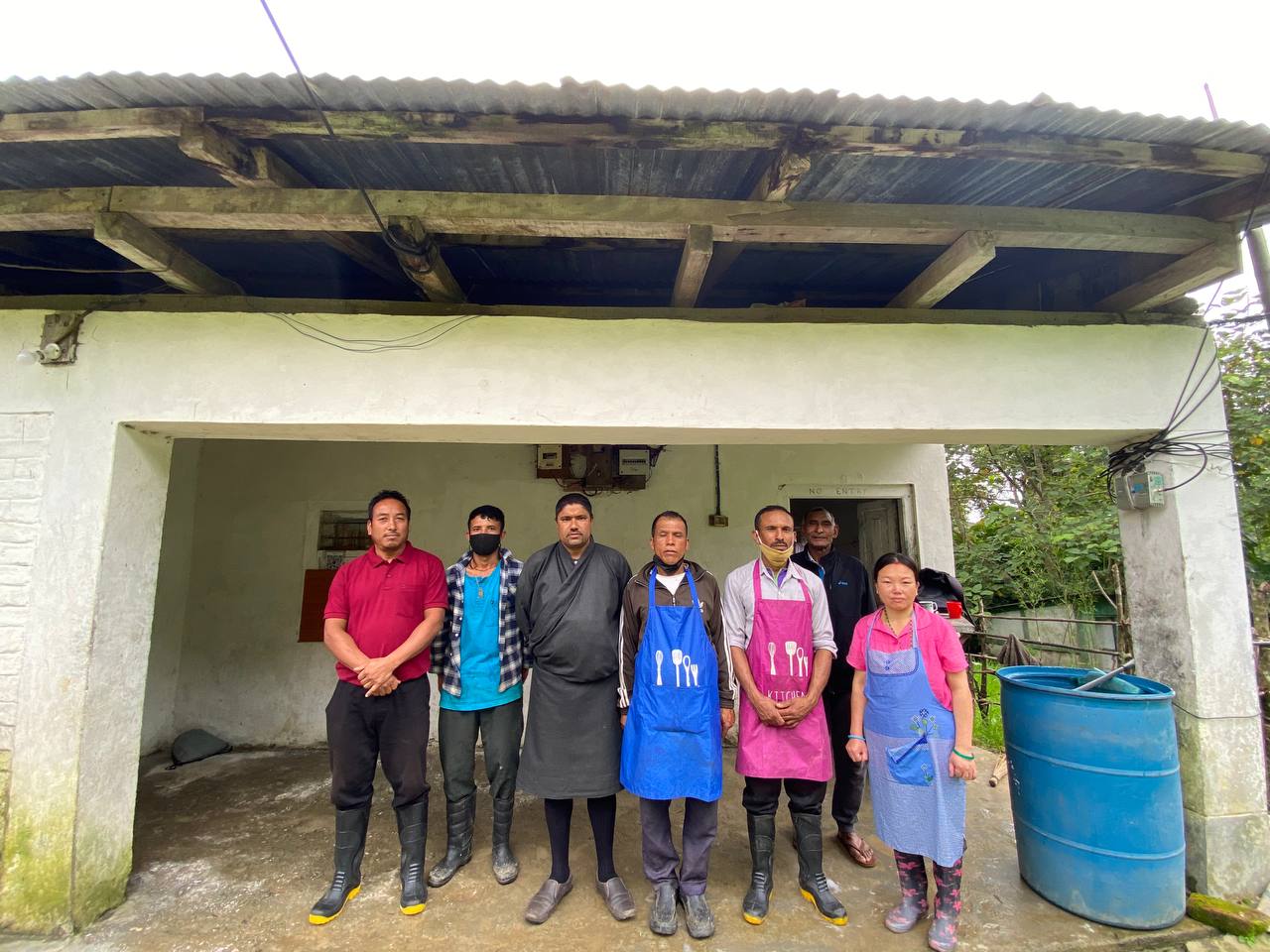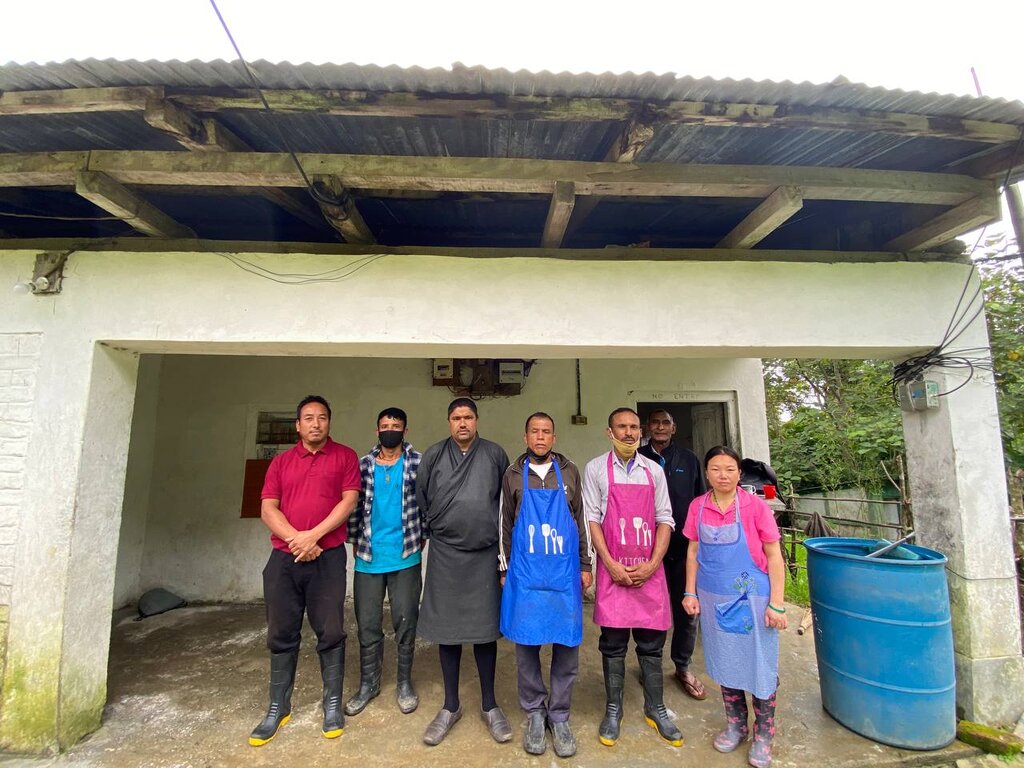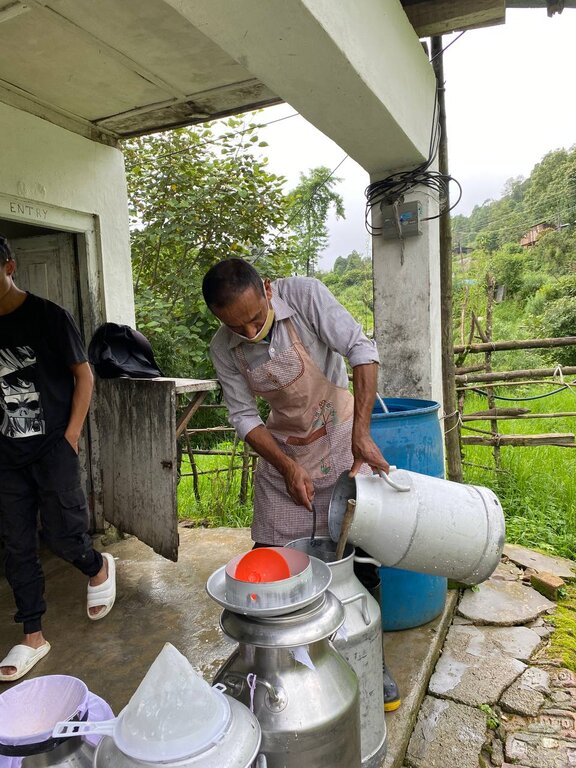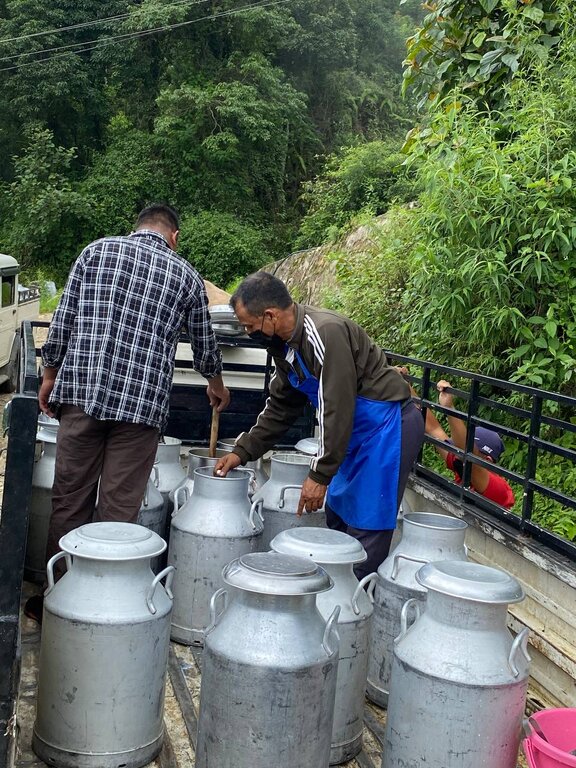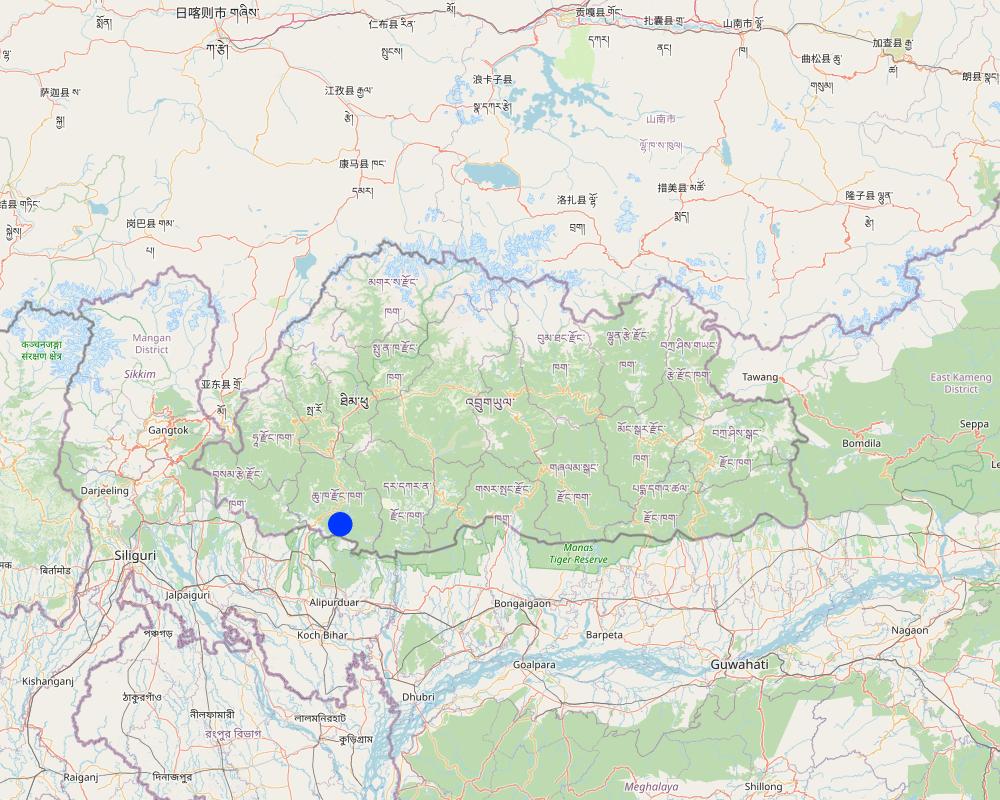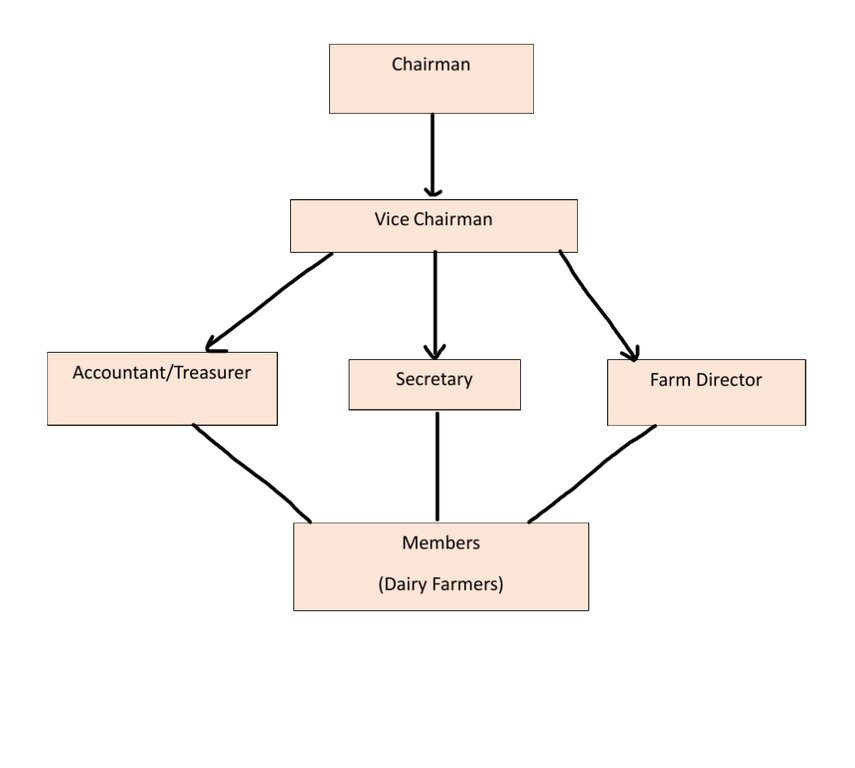Darla Dairy Cooperative [ប្រទេសប៊ូតង់]
- ការបង្កើត៖
- បច្ចុប្បន្នភាព
- អ្នកចងក្រង៖ Karma Wangdi
- អ្នកកែសម្រួល៖ chenga Tshering
- អ្នកត្រួតពិនិត្យច្រើនទៀត៖ William Critchley, Rima Mekdaschi Studer
Gonor Nyamley Detshen (སྒོ་ནོར་མཉམ་ལས་སྡེ་ཚན།)
approaches_6868 - ប្រទេសប៊ូតង់
ពិនិត្យមើលគ្រប់ផ្នែក
ពង្រីកមើលទាំងអស់ បង្រួមទាំងអស់1. ព័ត៌មានទូទៅ
1.2 ព័ត៌មានលម្អិតពីបុគ្គលសំខាន់ៗ និងស្ថាប័នដែលចូលរួមក្នុងការវាយតម្លៃ និងចងក្រងឯកសារនៃវិធីសាស្ត្រផ្សព្វផ្សាយ
បុគ្គលសំខាន់ម្នាក់ (ច្រើននាក់)
អ្នកប្រើប្រាស់ដី:
Samal Bal Kumar
17720749
Darla, Chukha Dzongkhag (District)
ប្រទេសប៊ូតង់
អ្នកប្រើប្រាស់ដី:
Gurung Pancha Maya
16931238
Darla Dairy Cooperative
Darla, Chukha Dzongkhag (District)
ប្រទេសប៊ូតង់
អ្នកប្រើប្រាស់ដី:
Chettri Datta Singh
16911283
Darla Dairy Cooperative
Darla, Chukha Dzongkhag (District)
ប្រទេសប៊ូតង់
អ្នកប្រើប្រាស់ដី:
Basnet Chandra Kumar
17810553
Darla Dairy Cooperative
Darla, Chukha Dzongkhag (District)
ប្រទេសប៊ូតង់
អ្នកប្រើប្រាស់ដី:
Kharki Ram
17480128
Darla Dairy Cooperative
Darla, Chukha Dzongkhag (District)
ប្រទេសប៊ូតង់
ឈ្មោះគម្រោងដែលបានចងក្រងឯកសារ/ វាយតម្លៃលើវិធីសាស្ត្រផ្សព្វផ្សាយ (បើទាក់ទង)
Strengthening national-level institutional and professional capacities of country Parties towards enhanced UNCCD monitoring and reporting – GEF 7 EA Umbrella II (GEF 7 UNCCD Enabling Activities_Umbrella II)ឈ្មោះអង្គភាពមួយ (ច្រើន) ដែលបានចងក្រងឯកសារ/ វាយតម្លៃលើវិធីសាស្ត្រផ្សព្វផ្សាយ (បើទាក់ទង)
National Soil Services Centre, Department of Agriculture, Ministry of Agriculture & Livestock (NSSC) - ប្រទេសប៊ូតង់1.3 លក្ខខណ្ឌទាក់ទងទៅនឹងការប្រើប្រាស់ទិន្នន័យដែលបានចងក្រងតាមរយៈវ៉ូខេត
តើពេលណាដែលទិន្នន័យបានចងក្រង (នៅទីវាល)?
17/07/2023
អ្នកចងក្រង និង(បុគ្គលសំខាន់ៗ)យល់ព្រមទទួលយកនូវលក្ខខណ្ឌនានាទាក់ទងទៅនឹងការប្រើប្រាស់ទិន្នន័យដែលបានចងក្រងតាមរយៈ វ៉ូខេត:
បាទ/ចា៎
2. ការពណ៌នាអំពីវិធីសាស្ត្រផ្សព្វផ្សាយ SLM
2.1 ពណ៌នាសង្ខេបខ្លីពីវិធីសាស្ត្រផ្សព្វផ្សាយ
The Darla dairy cooperative is an example of where farmers come together to form collective organizations for production, collection, transportation, processing, and marketing of milk and dairy products. These are business models operated as member-owned and member-controlled organizations.
2.2 ពណ៌នាលម្អិតពិវិធីសាស្ត្រផ្សព្វផ្សាយ
ពណ៌នាលម្អិតពិវិធីសាស្ត្រផ្សព្វផ្សាយ:
Livestock in Bhutan are reared for a multitude of purposes, encompassing the production of milk, food, and dung, as well as serving as a means of generating draught power, generating revenue, and accumulating assets. Dairy products, particularly butter and cheese, occupy significant significance within the Bhutanese nutritional framework and have emerged as a noteworthy economic resource for certain households in recent times. Knowing its importance many Bhutanese farmers are forming the cooperative groups. One thing that has been constantly growing over the years in Darla Gewog under Chhukha Dzongkhag is a Farmer’s Cooperative.
Darla dairy cooperatives are business owned and operated by dairy farmers, designed to collectively manage market milk and dairy products (Singh & Gupta, 2015). One of their main features is the collective ownership structure, where farmers become members and actively participate in decision-making processes. By pooling resources, dairy cooperatives enable farmers to access shared facilities, such as milk processing plants and storage, reducing individual cost and enhancing efficiency. Additionally, they offer fair and transparent pricing mechanisms, ensuring farmers receive a competitive price for their milk. Dairy cooperatives also provide valuable technical assistant, training, and access to markets, supporting farmer's growth and sustainability in the dairy industry (USDA, 2015).
The aims and objectives of dairy cooperatives revolve around empowering dairy farmers and promoting their collective welfare. One of the primary objectives is to facilitate shared ownership and democratic decision-making, allowing farmers to collectively manage their dairy operation. Another key aim is to ensure fair and equitable distribution of profits among members, promoting economic sustainability and social development within the dairy community. Dairy cooperatives also strive to provide access to modern technologies empowering farmers with the knowledge and skill needed for sustainable dairy farming practices (FAO, 2019).
The formation of a dairy cooperative typically involves several methods and steps to ensure successful establishment. Firstly, a core group of dairy farmers with common goals come together to initiate the cooperative. They conduct meetings, gauge interest, and identify potential members. Once the core group is established, they create formal bylaws that outline the cooperative's objectives, membership criteria, decision-making processes and profit-sharing mechanisms. To attract more members, awareness campaigns and informational sessions organized by gewog livestock extension agents showcase the benefits of joining the cooperatives. Financial planning and livestock management efforts are also undertaken to raise the necessary capital for initial investments, such as setting up milk processing facilities and infrastructures. There are 101 registered dairy farmers who contribute milk through the cooperative. The dairy cooperative is operated by 6 core members who manage the daily activities.
Dairy cooperatives play a crucial role in the dairy industry by bringing together various stakeholders and facilitating their collaboration. The primary stakeholders involved in dairy cooperative includes dairy farmers who are the core members and owner of the cooperative. They actively participate in decision-making and contribute their milk to the cooperative for processing and marketing. Additionally, consumers are significant stakeholders as they rely on dairy cooperatives to provide them with high quality milk and dairy product. Other stakeholders like the gewog livestock extension agent, the District livestock officer and other officials are involved in a meeting which is conducted twice a year. Marketing opportunities are the main driving forces for producers to produce more of any type of product. Identification of market opportunities and the development of proper marketing strategies for milk and milk products for selected groups of villages would be a useful approach to support dairy cooperatives.
2.3 រូបភាពនៃវិធីសាស្ត្រផ្សព្វផ្សាយ
2.5 ប្រទេស/តំបន់/ទីតាំងកន្លែង ដែលវិធីសាស្ត្រផ្សព្វផ្សាយត្រូវបានអនុវត្តន៍
ប្រទេស:
ប្រទេសប៊ូតង់
តំបន់/រដ្ឋ/ខេត្ត:
Chukha
បញ្ជាក់បន្ថែមពីលក្ខណៈនៃទីតាំង:
Darla
Map
×2.6 កាលបរិច្ឆេទនៃការចាប់ផ្តើម និងបញ្ចប់នៃវិធីសាស្រ្តផ្សព្វផ្សាយនេះ
សូមបញ្ជាក់ឆ្នាំដែលបានបង្កើតឡើង:
2014
ប្រសិនអត់ចាំឆ្នាំ សូមចង្អុលបង្ហាញកាលបរិច្ឆេទប្រហែលៗពេលដែលវិធីសាស្ត្រផ្សព្វផ្សាយត្រូវបានចាប់ផ្តើមប្រើ:
តិចជាង 10ឆ្នាំមុន (ថ្មី)
2.7 ប្រភេទនៃវិធីសាស្ត្រផ្សព្វផ្សាយ
- អ្នកផ្តួចផ្តើមក្នុងតំបន់/អ្នករុករកឃើញថ្មីៗ
2.8 គោលបំណង/ទិសដៅសំខាន់នៃវិធីសាស្ត្រផ្សព្វផ្សាយ
The dairy cooperative aims to increase income through marketing of surplus milk, by engaging unemployed youths. Such intervention is expected to address problem srelated to rural urban migration.
2.9 លក្ខខណ្ឌអនុញ្ញាត ឬរារាំងការអនុវត្តន៍បច្ចេកទេសដែលស្ថិតនៅក្រោមវិធីសាស្រ្តផ្សព្វផ្សាយ
ភាពអាចរកបាននៃធនធានហិរញ្ញវត្ថុ និងសេវាកម្ម
- អំណោយផល
Priority support is given to the group and cooperatives in terms of investment and financial support by the government.
ការសហការ/ការសម្របសម្រួលតួអង្គពាក់ព័ន្ធ
- អំណោយផល
Dairy cooperative enables farmers' to access and shared facilities, by pooling resources
ទីផ្សារ (ទិញធាតុចូល លក់ផលិតផល) និងតម្លៃ
- អំណោយផល
Increasing demand for milk and dairy products motivate farmers' to raise more dairy cattle and increase production
ទំហំការងារ ភាពអាចរកបាននៃកម្លាំងពលកម្ម
- អំណោយផល
Enabled sharing of workload equitabily
3. ការចូលរួម និងតួនាទីរបស់ភាគីពាក់ព័ន្ធ
3.1 អ្នកពាក់ព័ន្ធដែលបានចូលរួមក្នុងវិធីសាស្ត្រផ្សព្វផ្សាយ និងតួនាទីរបស់ពួកគេ
- អ្នកប្រើប្រាស់ដីក្នុងតំបន់/សហគមន៍
Dairy farmers
Actively participate in decision-making and, produce and supply milk to the cooperative for processing and marketing as specified in the bylaw
- រដ្ឋាភិបាលថ្នាក់មូលដ្ឋាន
Livestock Extension Agent
Provide technical supports (health, feed and fodder, breeding and management) and monitor the progress of cooperative
- រដ្ឋាភិបាលថ្នាក់ជាតិ (អ្នករៀបចំផែនការ អ្នកសម្រេចចិត្ត)
District Livestock Officer
Royal audit authority
Assist in prioritization of issues and planning
Mobilize human and financial resources
Monitor and ensure adequate financial supports
3.2 ការចូលរួមរបស់អ្នកប្រើប្រាស់ដីក្នុងតំបន់/ សហគមន៍ក្នុងតំបន់ក្នុងដំណាក់កាលផ្សេងគ្នានៃវិធីសាស្រ្តផ្សព្វផ្សាយ
| ការចូលរួមរបស់អ្នកប្រើប្រាស់ដីក្នុងតំបន់/សហគមន៍ក្នុងតំបន់ | សូមបញ្ជាក់នរណាត្រូវបានចូលរួម ព្រមទាំងពណ៌នាសកម្មភាពទាំងនោះ | |
|---|---|---|
| ការចាប់ផ្តើម/ការលើកទឹកចិត្ត | អន្តរកម្ម | The core dairy farmers with guidance from the Gewog Livestock Extension Agent came up with ideas to establish a dairy cooperative/group. |
| ការរៀបចំផែនការ | អន្តរកម្ម | Core members along with intellectual people from the village assisted by gewog livestock extension agent planned and proposed. |
| ការអនុវត្តន៍ | អន្តរកម្ម | Interested dairy farmers supported by the gewog livestock agent and dzongkhag implemented the activity following the workplan and bylaws agreed upon. |
| ការត្រួតពិនិត្យ និងវាយតម្លៃ | ការគាំទ្រពីខាងក្រៅ | The activities of the dairy cooperatives are monitored periodically through field visit, monthly report, Bi-annual general assembly meeting and annual audit. |
3.3 គំនូសបំព្រួញ (ប្រសិនបើមាន)
ការពណ៌នា:
Presented flow chart of Darla Dairy cooperatives with engagement of all the members
អ្នកនិពន្ធ:
Terms of Reference of Darla Dairy Cooperatives
3.4 ការសម្រេចចិត្តលើការជ្រើសរើសបច្ចេកទេស SLM
សូមបញ្ជាក់តើអ្នកណាជាអ្នកបានសម្រេចចិត្តក្នុងការជ្រើសរើសបច្ចេកទេសដើម្បីយកមកអនុវត្តន៍:
- អ្នកប្រើប្រាស់ដីដោយខ្លួនឯងផ្ទាល់ (គំនិតផ្តួចផ្តើមដោយខ្លួនឯង)
ចូរពន្យល់:
The idea was conceptualized by the core group members, and accordingly planned and dairy cooperative was established initially. The engagement of other stakeholders came after the establishment.
សូមបញ្ជាក់ តើការសម្រេចធ្វើឡើងដោយផ្អែកលើអ្វីជាមូលដ្ឋាន:
- បទពិសោធន៍ និងគំនិតផ្ទាល់ខ្លួន(ពុំមានចងក្រងជាឯកសារ)
4. ជំនួយបច្ចេកទេស ការកសាងសមត្ថភាព និងការគ្រប់គ្រងចំណេះដឹង
4.1 ការកសាងសមត្ថភាព/ បណ្តុះបណ្តាល
តើវគ្គបណ្តុះបណ្តាលបានផ្តល់ឱ្យអ្នកប្រើប្រាស់ដី/អ្នកពាក់ព័ន្ធផ្សេងៗទៀតដែរឬទេ?
បាទ/ចា៎
សូមបញ្ជាក់តើអ្នកណាត្រូវបានបណ្តុះបណ្តាល:
- អ្នកប្រើប្រាស់ដី
ទម្រង់នៃការបណ្តុះបណ្តាល:
- អនុវត្តន៍ជាមួយការងារ
ប្រធានបទបណ្តុះបណ្តាល:
Group mobilization, bookkeeping , planning
Hygienic and clean milk production, collection, transportation, and processing.
Breeding and management (AI, Housing, feeding system)
មតិយោបល់:
The specialized training was provided by subject matter specialist, and on basic topic by the respective Extension Agent
4.2 សេវាផ្តល់ប្រឹក្សាយោបល់
តើអ្នកប្រើប្រាស់ដីបានទទួលនូវសេវាផ្តល់ប្រឹក្សាដែរ ឬទេ?
បាទ/ចា៎
សូមបញ្ជាក់ប្រសិនបើសេវាកម្មប្រឹក្សាយោបល់ត្រូវបានផ្តល់ឱ្យ:
- នៅលើដីរបស់អ្នកប្រើប្រាស់ដី
ពណ៌នា/ពន្យល់:
Officials from NCOA Yusipang monitored their work, and livestock officials organized awareness program on the management, care, prevention and control of common cattle diseases
4.3 ការពង្រឹងសមត្ថភាពស្ថាប័ន (ការអភិរឌ្ឍន៍អង្គភាព)
តើស្ថាប័នទាំងអស់ត្រូវបានបង្កើតឡើង ឬពង្រឹងសមត្ថភាពតាមរយៈវិធីសាស្ត្រផ្សព្វផ្សាយដែរ ឬទេ?
- បាទ/ច៎ា ជាមធ្យម
សូមបញ្ជាក់ថាតើស្ថាប័នត្រូវបានពង្រឹង ឬបង្កើតឡើងនៅត្រឹមកម្រិតណា(ច្រើន)?
- ថ្នាក់មូលដ្ឋាន
ចូពណ៌នាពីស្ថាប័ន តួនាទី និងទំនួលខុសត្រូវ សមាជិក ។ល។:
The number of dairy cooperative members have increased by 15 households.
សូមបញ្ជាក់ប្រភេទនៃការគាំទ្រ:
- សម្ភារៈ
សូមផ្តល់ព័ត៌មានបន្ថែមទៀតឱ្យបានលម្អិត:
All members of the cooperative were supplied with milk cans to collect, store and transport milk
4.4 ការត្រួតពិនិត្យ និងវាយតម្លៃ
តើការត្រួតពិនិត្យ និងវាយតម្លៃគឺជាផ្នែកមួយនៃវិធីសាស្ត្រដែរឬទេ?
បាទ/ចា៎
មតិយោបល់:
Physical on site monitoring and evaluating the quality, standard, cleanliness of the work and products
ប្រសិន បាទ/ច៎ា តើឯកសារនេះបានបង្កើតឡើងក្នុងគោលបំណងប្រើប្រាស់សម្រាប់ការត្រួតពិនិត្យ និងវាយតម្លៃដែរឬទេ?
ទេ
4.5 ការស្រាវជ្រាវ
តើការស្រាវជ្រាវ គឺជាផ្នែកមួយនៃវិធីសាស្រ្តដែរឬទេ?
ទេ
5. ថវិកា និងសម្ភារៈឧបត្ថម្ភពីខាងក្រៅ
5.1 ថវិកាប្រចាំឆ្នាំសម្រាប់ផ្សព្វផ្សាយ SLM
ប្រសិនបើចំនួនពិតប្រាកដនៃថវិកាប្រចាំឆ្នាំមិនត្រូវបានដឹងច្បាស់ សូមប្រាប់ពីចន្លោះនៃថវិកានោះ:
- 10,000-100,000
មតិយោបល់ (ឧ. ប្រភពសំខាន់នៃមូលនិធិ/ម្ចាស់ជំនួយចំបង):
The approach was implemented with the seed money collected from the members.
5.2 ការគាំទ្រផ្នែកហិរញ្ញវត្ថុ / សម្ភារៈដែលបានផ្តល់ទៅឱ្យអ្នកប្រើប្រាស់ដី
តើអ្នកប្រើប្រាស់ដីបានទទួលការគាំទ្រផ្នែកហិរញ្ញវត្ថ/សម្ភារៈសម្រាប់ការអនុវត្តន៍បច្ចេកទេសដែរឬទេ:
បាទ/ចា៎
ប្រសិនបាទ/ច៎ា សូមបញ្ជាក់ប្រភេទ(ច្រើន)នៃការគាំទ្រ លក្ខខណ្ឌ និងអ្នកផ្តល់ឱ្យ(ច្រើន):
They were provided with the milk processing equipment
5.3 សូមបញ្ជាក់ពីធាតុចូលត្រូវបានផ្តល់បដិភាគ (រួមទាំងកម្លាំងពលកម្ម)
- កសិកម្ម
| សូមបញ្ជាក់ ធាតុចូលណាខ្លះដែលបានផ្តល់បដិភាគ | កម្រិតទំហំប៉ុណ្ណា | សូមបញ្ជាក់ពីការបដិភាគ |
|---|---|---|
| Machines | ផ្តល់ហិរញ្ញវត្ថុទាំងស្រុង | -Chunning machine -Office furnitures - cream separator -analyzer -yogurt incubator -deep freezer and fridge |
មតិយោបល់:
The government fully funded construction of milk processing, and is being operated by the cooperative free of cost.
5.4 ឥណទាន
តើឥណទានដែលបានផ្តល់នៅក្រោមវិធីសាស្ត្រផ្សព្វផ្សាយសម្រាប់សកម្មភាព SLM នេះយ៉ាងដូចម្តេច?
ទេ
5.5 ការលើកទឹកចិត្ត ឬវិធីសាស្ត្រដ៏ទៃទៀត
តើមានការលើកទឹកចិត្តផ្សេងទៀត ឬឧបករណ៍ប្រើប្រាស់ដើម្បីលើកកម្ពស់ការអនុវត្តន៍បច្ចេកទេស SLM?
ទេ
6. ការវិភាគរកផលប៉ះពាល់ និងសេចក្តីសន្និដ្ឋាន
6.1 ផលប៉ះពាល់នៃវិធីសាស្ត្រផ្សព្វផ្សាយ
តើវិធីសាស្ត្រផ្សព្វផ្សាយបានផ្តល់សិទ្ធិអំណាចដល់អ្នកប្រើប្រាស់ដី ធ្វើឱ្យប្រសើរឡើងនូវការចួលរួមអ្នកពាក់ព័ន្ធ?
- ទេ
- បាទ/ច៎ា បន្តិចបន្តួច
- បាទ/ច៎ា ជាមធ្យម
- បាទ/ច៎ា បានខ្លាំង
They got more recognition and support
តើវិធីសាស្រ្តផ្សព្វផ្សាយនេះអនុញ្ញាតឱ្យធ្វើការសម្រេចចិត្ដដោយផ្អែកលើភស្តុតាងជាមូលដ្ឋានដែរ ឬទេ?
- ទេ
- បាទ/ច៎ា បន្តិចបន្តួច
- បាទ/ច៎ា ជាមធ្យម
- បាទ/ច៎ា បានខ្លាំង
future plans are drawn based on the needs, issues and challages faced during the operation of dairy cooperative
តើវីធីសាស្ត្រនេះបានជួយកសាង/ពង្រឹងស្ថាប័ន កិច្ចសហប្រតិបត្តិការរវាងអ្នកពាក់ព័ន្ធដែរ ឬទេ?
- ទេ
- បាទ/ច៎ា បន្តិចបន្តួច
- បាទ/ច៎ា ជាមធ្យម
- បាទ/ច៎ា បានខ្លាំង
Physical and financial support received have enhanced, improved social cohesion
តើវិធីសាស្ត្រផ្សព្វផ្សាយ បានធ្វើឱ្យប្រសើរឡើងសមភាពយេនឌ័រ និងផ្តល់សិទិ្ធអំណាចដល់ស្ត្រី និងក្មេងស្រី?
- ទេ
- បាទ/ច៎ា បន្តិចបន្តួច
- បាទ/ច៎ា ជាមធ្យម
- បាទ/ច៎ា បានខ្លាំង
Every men and women is given equal right.
តើវិធីសាស្ត្រផ្សព្វផ្សាយនាំឱ្យប្រសើរឡើងនូវសន្តិសុខស្បៀង/ធ្វើឱ្យប្រសើរឡើងនូវអាហាររូបត្ថម្ភ?
- ទេ
- បាទ/ច៎ា បន្តិចបន្តួច
- បាទ/ច៎ា ជាមធ្យម
- បាទ/ច៎ា បានខ្លាំង
Increased milk and dairy products and excess dairy products are processed and supplied to schools, hospitals and other markets.
តើវិធីសាស្ត្រផ្សព្វផ្សាយធ្វើឱ្យប្រើសើរឡើងនូវការស្វែងរកទីផ្សារ?
- ទេ
- បាទ/ច៎ា បន្តិចបន្តួច
- បាទ/ច៎ា ជាមធ្យម
- បាទ/ច៎ា បានខ្លាំង
Formalized group marketing, and the quality of milk products have improved
តើវិធីសាស្ត្រផ្សព្វផ្សាយនេះនាំឱ្យមានការងារ ឱកាសរកប្រាក់ចំណូល?
- ទេ
- បាទ/ច៎ា បន្តិចបន្តួច
- បាទ/ច៎ា ជាមធ្យម
- បាទ/ច៎ា បានខ្លាំង
Some school drop-outs and laid-off youths are employed in collecting and transportation of milk.
6.2 ការលើកទឹកចិត្តចម្បងៗរបស់អ្នកប្រើប្រាស់ដីសម្រាប់ការអនុវត្តបច្ចេកទេស SLM
- បង្កើនប្រាក់ចំណេញ (សមត្ថភាព) បង្កើនអត្រាចំណេញ
Member earn an average gross monthly income between Nu. 30000-40000
- ការចំណាយ/បដិភាគ
Government provide subsidies (materials support) for the construction of improved dairy shed
- ការផ្សារភ្ជាប់ទៅនឹងចលនា/គម្រោង/ក្រុម/បណ្តាញ
Their products are marketed within the gewog, and excess products are marketed to other districts
6.3 សកម្មភាពផ្សព្វផ្សាយដែលប្រកបដោយចីរភាព
តើអ្នកប្រើប្រាស់ដីអាចធ្វើឱ្យមានចីរភាពនូវអ្វីដែលត្រូវបានអនុវត្តន៍តាមរយៈវិធីសាស្ត្រផ្សព្វផ្សាយដែរឬទេ(ដោយពុំមានការគាំទ្រពីអ្នកខាងក្រៅ)?
- បាទ/ចា៎
ប្រសិនបាទ/ច៎ា សូមរៀបរាប់ថាធ្វើយ៉ាងម៉េច:
The initial investment has been recovered, and current income meets the operation cost.
6.4 ភាពខ្លាំង/ គុណសម្បត្តិនៃវិធីសាស្ត្រផ្សព្វផ្សាយ
| ភាពខ្លាំង/ គុណសម្បត្តិ/ ឱកាស ទស្សនៈរបស់អ្នកប្រើប្រាស់ដី |
|---|
| Source of cash income |
| Increased cooperation and network |
| improve household livelihood |
| ភាពខ្លាំង/ គុណសម្បត្តិ/ ឱកាស ទស្សនៈរបស់បុគ្គលសំខាន់ៗ |
|---|
| Creates employment opportunities to the school drop-outs and rural youths |
| Contributes to food security and better nutrition |
6.5 ភាពខ្សោយ/ គុណវិបត្តិនៃវិធីសាស្ត្រ និងរកដំណោះស្រាយ
| ភាពខ្សោយ/ គុណវិបត្តិ/ ហានិភ័យ ទស្សនៈរបស់អ្នកប្រើប្រាស់ដី | តើបច្ចេកទេសទាំងនោះបានដោះស្រាយបញ្ហាដូចម្តេច? |
|---|---|
| Scattered settlement and production | Increase the number of transportation vehicles, improve road connectivity |
| Short shelf life of milk | Try marketing in nearby places if possible, install cold chain facilities |
| Delay in payment | Create a terms of agreement with the retailers to ensure payment on time |
| ភាពខ្សោយ/ គុណវិបត្តិ/ ហានិភ័យក្នុងទស្សនៈរបស់បុគ្គលសំខាន់ៗ | តើបច្ចេកទេសទាំងនោះបានដោះស្រាយបញ្ហាដូចម្តេច? |
|---|---|
| No proper market outlet for wholesale marketing | explore market outside gewog |
7. ឯកសារយោង និងវេបសាយ
7.1 វិធីសាស្ត្រ/ ប្រភពនៃព័ត៌មាន
- តាមការចុះទីវាល ការស្រាវជ្រាវនៅទីវាល
5
- ការសម្ភាសន៍ជាមួយអ្នកប្រើប្រាស់ដី
5
7.3 ចូលទៅទាញយកឯកសារពាក់ព័ន្ធដែលមានលើបណ្តាញអ៊ិនធឺណែត
ចំណងជើង/ ពណ៌នា:
Cooperatives in the Dairy Industry
វេបសាយ:
https://www.google.com/url?sa=t&source=web&rct=j&opi=89978449&url=https://www.rd.usda.gov/files/cir1-16.pdf&ved=2ahUKEwi9z4b8-Z6AAxV7umMGHQsgBZUQFnoECBMQAQ&usg=AOvVaw0jmrAUETNEh8crEba04qjj
ចំណងជើង/ ពណ៌នា:
Dairy development through cooperative structure
វេបសាយ:
https://www.fao.org/3/T3080T/t3080T0a.htm
ចំណងជើង/ ពណ៌នា:
Analysis of knowledge and adoption level of the dairy farmers regarding clean milk production (CMP) practices
វេបសាយ:
https://www.indianjournals.com/ijor.aspx?target=ijor:jdfhs&volume=34&issue=3&article=002
ការតភ្ជាប់ និងម៉ូឌុល
ពង្រីកមើលទាំងអស់ បង្រួមទាំងអស់ការតភ្ជាប់
គ្មានការតភ្ជាប់
ម៉ូឌុល
គ្មានម៉ូឌុល


